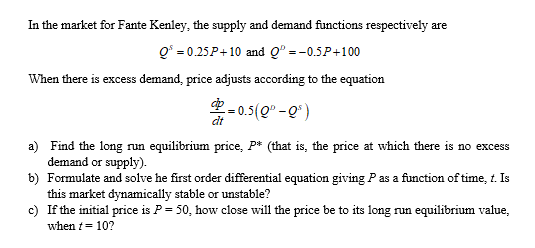In the market for Fante Kenley, the supply and demand functions respectively are Q° = 0.25P+10 and Q° =-0.5P+100 When there is excess demand, price adjusts according to the equation 2-0.5(Q° -Q°) a) Find the long run equilibrium price, P* (that is, the price at which there is no excess demand or supply). b) Formulate and solve he first order differential equation giving Pas a function of time, 1. Is this market dynamically stable or unstable? c) If the initial price is P= 50, how close will the price be to its long run equilibrium value, when t= 10?
In the market for Fante Kenley, the supply and demand functions respectively are Q° = 0.25P+10 and Q° =-0.5P+100 When there is excess demand, price adjusts according to the equation 2-0.5(Q° -Q°) a) Find the long run equilibrium price, P* (that is, the price at which there is no excess demand or supply). b) Formulate and solve he first order differential equation giving Pas a function of time, 1. Is this market dynamically stable or unstable? c) If the initial price is P= 50, how close will the price be to its long run equilibrium value, when t= 10?
Managerial Economics: Applications, Strategies and Tactics (MindTap Course List)
14th Edition
ISBN:9781305506381
Author:James R. McGuigan, R. Charles Moyer, Frederick H.deB. Harris
Publisher:James R. McGuigan, R. Charles Moyer, Frederick H.deB. Harris
Chapter3: Demand Analysis
Section: Chapter Questions
Problem 1E: The Potomac Range Corporation manufactures a line of microwave ovens costing $500 each. Its sales...
Related questions
Question

Transcribed Image Text:In the market for Fante Kenley, the supply and demand functions respectively are
Q° = 0.25P+ 10 and Q° =-0.5P+100
When there is excess demand, price adjusts according to the equation
-0.5(Q" -0)
dt
a) Find the long run equilibrium price, P* (that is, the price at which there is no excess
demand or supply).
b) Formulate and solve he first order differential equation giving Pas a function of time, t. Is
this market dynamically stable or unstable?
c) If the initial price is P = 50, how close will the price be to its long run equilibrium value,
when t= 10?
Expert Solution
This question has been solved!
Explore an expertly crafted, step-by-step solution for a thorough understanding of key concepts.
This is a popular solution!
Trending now
This is a popular solution!
Step by step
Solved in 4 steps

Knowledge Booster
Learn more about
Need a deep-dive on the concept behind this application? Look no further. Learn more about this topic, economics and related others by exploring similar questions and additional content below.Recommended textbooks for you

Managerial Economics: Applications, Strategies an…
Economics
ISBN:
9781305506381
Author:
James R. McGuigan, R. Charles Moyer, Frederick H.deB. Harris
Publisher:
Cengage Learning


Managerial Economics: Applications, Strategies an…
Economics
ISBN:
9781305506381
Author:
James R. McGuigan, R. Charles Moyer, Frederick H.deB. Harris
Publisher:
Cengage Learning
